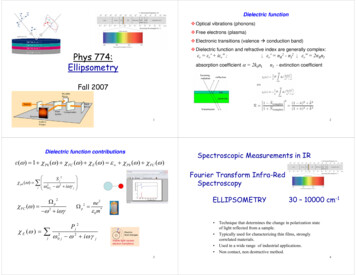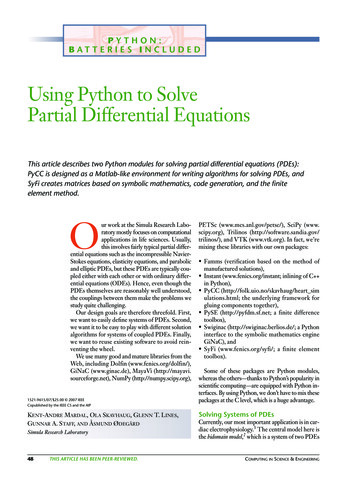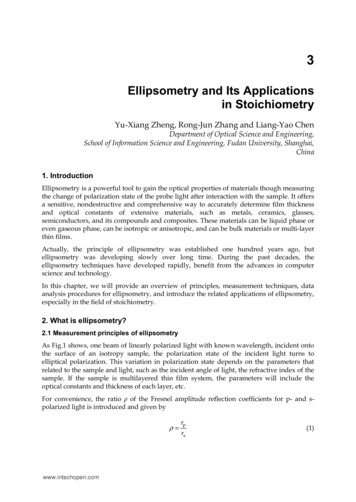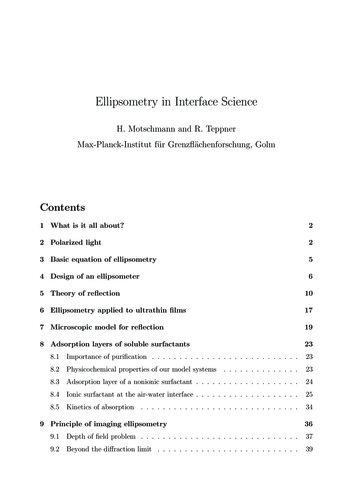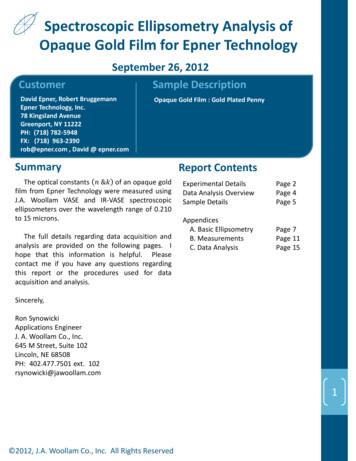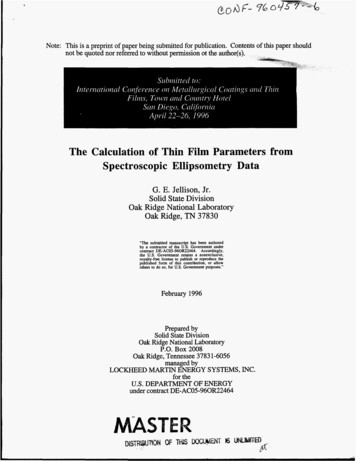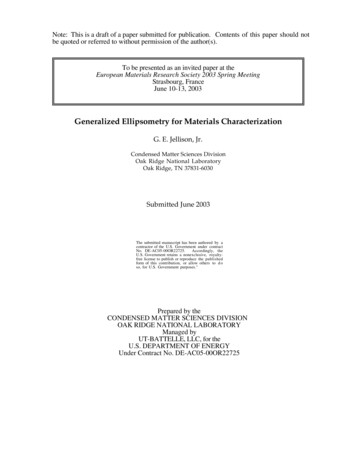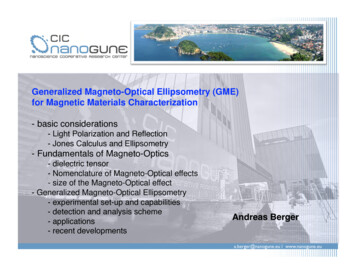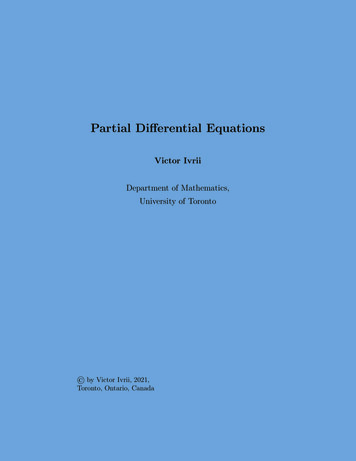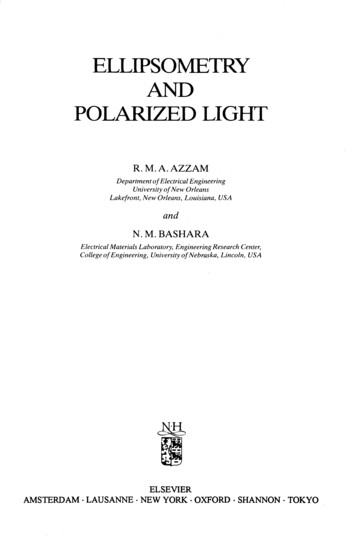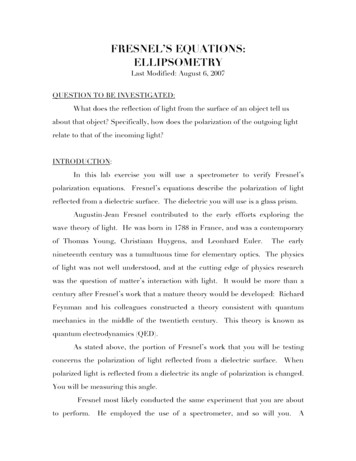
Transcription
FRESNEL’S EQUATIONS:ELLIPSOMETRYLast Modified: August 6, 2007QUESTION TO BE INVESTIGATED:What does the reflection of light from the surface of an object tell usabout that object? Specifically, how does the polarization of the outgoing lightrelate to that of the incoming light?INTRODUCTION:In this lab exercise you will use a spectrometer to verify Fresnel’spolarization equations. Fresnel’s equations describe the polarization of lightreflected from a dielectric surface. The dielectric you will use is a glass prism.Augustin-Jean Fresnel contributed to the early efforts exploring thewave theory of light. He was born in 1788 in France, and was a contemporaryof Thomas Young, Christiaan Huygens, and Leonhard Euler.The earlynineteenth century was a tumultuous time for elementary optics. The physicsof light was not well understood, and at the cutting edge of physics researchwas the question of matter’s interaction with light. It would be more than acentury after Fresnel’s work that a mature theory would be developed: RichardFeynman and his colleagues constructed a theory consistent with quantummechanics in the middle of the twentieth century. This theory is known asquantum electrodynamics (QED).As stated above, the portion of Fresnel’s work that you will be testingconcerns the polarization of light reflected from a dielectric surface. Whenpolarized light is reflected from a dielectric its angle of polarization is changed.You will be measuring this angle.Fresnel most likely conducted the same experiment that you are aboutto perform.He employed the use of a spectrometer, and so will you.A
spectrometer is a device that allows you to make accurate angularmeasurements. You will probe the interaction between input light and a prismby determining angles of reflection, refraction, and polarization.The lightsource you will use is a high-output mercury vapor lamp. This lamp does outputa significant amount of UV radiation, which has been filtered out by a largegreen filter at the lamps output. You may wish to cover any leaks on otherportions of the lamp with tape.The input of the spectrometer is a collimating tube (see Figure 1). Lightpasses through the collimating tube and is sent across the stage. The rotationaxis of the spectrometer is perpendicular to the plane of the stage. All angularmeasurements are made about this axis, and you should take care whenpositioning the prism.Reflections and refractions from the prism will beviewed directly through a telescope.This telescope also rotates about thespectrometer and is connected to the measurement disk upon which is anangular mtheunderstanding of the physics inherent to Fresnel’s work. Ellipsometry is nowof common use in many fields where the optical characteristics of dielectricsubstances are of interest.Such substances include: Cell membranes,semiconductors, microelectronics, and many others.2
Figure 1. The spectrometer you will be using.THEORY:Fresnel’s equations are commonly given in the form(1)(2)Where,i angle of incidencer angle of refractionRs Reflected perpendicular componentRp Reflected parallel componentEs Incident perpendicular componentEp Incident parallel componentWhen the electric vector of the incident light is polarized at 45 (i.e., Es Ep)Eqs. (1) and (2) may combined such that3
therefore,(3)Thus, Eq. (3) tells us the ratio of the reflected electric vector’scomponents as a function of incident and refracted angles.Let’s summarize. There are two kinds of angles to keep track of: anglesdefined by the position of the telescope relative to the collimator (i and r),and the polarization angles which lie in planes perpendicular to the plane ofincidence.Eq. (3) relates the two kinds of angles. This is important tounderstand.Eq. (3) will be the form of Fresnel’s equations that you will verify. Froma terse observation it is apparent that to compute values for Rp/Rs you will needto know corresponding values of the refraction angle r and incidence angle i.The angle i will be obtained directly from the position of the telescope whentrained on the reflected beam.The angle of refraction r will need to beobtained from Snell’s Law:(4)In order to complete our quest for the refraction angle we will now needto know the index of refraction n of the prism. This value may be obtainedfrom the following expression.(5)Where, A is the internal angle of the prism and D is the minimumdeviation angle of the prism. The minimum deviation angle is a parameter ofthe prism and is shown in Figure 2. When an incident beam is refracted suchthat it travels parallel to a side of the prism, the angle created between the4
machine axis and this finally refracted beam is the angle of minimum deviationD.The machine axis is defined for convenience of measurement.It is astraight line traveling from the input light into the telescope when nothing hasbeen placed on the stage. All measurements may be made relative to this axis.You will not only use the index of refraction in Snell’s law; you can alsocalculate the Brewster angle θb, as defined by(6)The Brewster angle is the angle of incidence where all reflections arecompletely p-polarized, and will thus serve as a good position for calibration, asyou shall see later.PROCEDURE:In this experiment you will conduct the following:-Alignment and calibration of the spectrometer and polarizers5
-Measurement of the prism’s index of refraction-Experimental verification of Fresnel’s equations (Eq. 3)Alignment:First, you should check the level of the base of the spectrometer. Dothis by removing the stage (see Figure 1) and placing a bubble level onto thecentral post. Now adjust the leg screws as necessary. Replace the stage andlevel it accordingly. Make sure to rotate the bubble level while on the stage andthe post.Next the collimator and telescope (Figure 1) need to be leveled andfocused. You will do this by using a collimated target that is not connected tothe spectrometer. This target is fully collimated when viewed through the lensattached to it. Measure the height of the ends of the target to ensure that it islevel. Adjust the tilt and focus of the telescope until the target is crisp andcentered on the telescope’s crosshairs.Therefore, when you focus thetelescope to it you are ensuring that the tilt and focus of the scope are correct.Now, using the mercury vapor lamp as a source, train the newly alignedtelescope onto the collimator. By adjusting the tilt and focus of the collimatoryou should achieve a good image of the mercury vapor source.Index of Refraction:Before testing Fresnel’s equations you will need to determine the prism’sindex of refraction. First, establish a machine axis by looking straight acrossthe stage while it is empty. This will allow you to set the measurement disk atan easy point of reference.Place the prism onto stage and rotate the telescope to closelyapproximate the configuration in Fig. 2. Observe the refracted image throughthe telescope. Begin slowly rotating the stage.You will have to follow the6
image with the telescope. When you have reached the minimum deviationangle D the refracted image will cease moving and begin to return back in theopposite direction, even though you have not changed the direction of thestage’s rotation. The minimum deviation angle is located at the cusp where theimage changes direction. Repeat this procedure to arrive at an average valuefor n2 (that of the prism) from [Eq. (5)], and be sure to associate the appropriateerror in this measurement and calculation. Using your average value for n2 andits error, calculate Brewster’s angle and its error.Be sure to use anappropriately accurate value for the index of refraction of air.Polarization by Scattering of Light:You are now ready to study Fresnel’s equations, and to measureBrewster’s angle with reflected light. You will do this by finding the reflected light’spolarization φ angle at various angles of incidence i. Replace the polarizer onto thetelescope, we will refer to this polarizer as “the analyzer.” You must now createthe conditions such that Eq. (3) is true, i.e. Es Ep. To do this you must firstalign the analyzer with the plane of incidence.Observe a reflection from the prism with the incident light at theBrewster angle, Eq. (6). Adjust the polarizer so that extinction of the imagecorresponds to 0º (If you have aligned everything correctly this will leave thezero on the analyzer pointing straight up). The analyzer is now aligned with thes-component of the reflected E field, which does not exist at the Brewsterangle. You have calibrated the analyzer to be perpendicular to the plane ofincidence so that all future measurements of the polarization angle φ will berelative to this position. Now, remove the prism and rotate the telescope so thatyou are looking directly into the collimator (180 ), this establishes a machineaxis; set the scale accordingly.7
You will now make Es equal to Ep. Set the analyzer to 45º from thecalibrated position (0 ); you should still be able to see the slit.Attach thesecond polarizer to the end of the collimator and rotate it until extinctionoccurs. (Fix the collimator’s polarizer with a small clamp for the remainder ofthe experiment so that it does not waver.) Thes and p components of the electric vector arenow equal, and Eq. (3) is now valid.For each value of the incidence angle iEq. (3) will provide you with a theoretical valuefor Rp/Rs. For a range of incident angles youwill experimentally determine Rp/Rs by rotatingthe analyzer until extinction occurs and thenrecordingcalibration.this angle φrelativetoyourThis extinction will occur for arange of φ, you should attempt to locate the center of this range. φ representsthe orientation of the resultant vector from the addition of the s and pcomponent of the reflected E field.Therefore the tangent of this anglerepresents Rp/Rs, see Figure 3 for clarification. This is extremely important tounderstand.Plot your experimentally derived values for Rp/Rs vs. i with error bars.Show that this correlates significantly to the behavior predicted by Eq. (3).Report the index of refraction that you determined along with the Brewsterangle for this prism.8
A technique known as ellipsometry has developed from the understanding of the physics inherent to Fresnel’s work. Ellipsometry is now . When the electric vector of the incident light is polarized at 45 (i.e., E s E p) Eqs. (1) and (2) may combined such that . 4 therefore, (3) Thus,

